When traveling in Japan, you might be unsure about when and how to bow or what the proper manners are at a shrine. But don’t worry! With this guide, you’ll grasp the basics, ensuring you can confidently navigate these situations wherever you go.
The History and Significance of Bowing
In Japan, bowing is more than just a greeting. The practice of bowing has deep roots, influenced by Bushido (the way of the samurai) and Buddhism. During the Edo period, bowing became ingrained in society and continues to be an important part of Japanese culture today. Bowing is a fundamental way to show respect and is used in a wide variety of situations in everyday life.
Types of Bows and When to Use Them
There are several types of bows, each used in different situations:
- Eshaku (会釈): A light bow of about 15 degrees. This bow is used in casual settings, like when greeting friends or colleagues with a quick “hello.” It’s the most common bow in daily life.
- Keirei (敬礼): A bow of about 30 degrees. This is used in more formal situations, such as when greeting someone senior or someone you respect, like a boss or elder. It’s commonly seen in business settings.
- Saikeirei (最敬礼): A deep bow of 45 degrees or more. This is used when offering a sincere apology, showing deep gratitude, or making a special request. It conveys the highest level of respect to the other person.
By using these bows appropriately, you can navigate social interactions in Japan smoothly and leave a positive impression on those you meet.
Everyday Situations Where Bowing is Common
Bowing is a regular part of daily life in Japan. Here are some common situations where you’ll see or be expected to bow:
- Greetings: In the morning, people often say “Ohayou gozaimasu” (Good morning) with a bow, or “Otsukaresama deshita” (Thank you for your hard work) at the end of the day. When greeting someone senior, a slight bow is typically included to show respect.
- Business Settings: Bowing is frequent in business, whether it’s during meetings, negotiations, or interviews. When exchanging business cards, it’s polite to bow as you present your card.
- Apologies: When apologizing, people often bow deeply, using the saikeirei bow to express their sincerity. The depth of the bow shows how serious the apology is.
- Expressions of Gratitude: When receiving help or when someone does something for you, it’s customary to bow to show your appreciation. A keirei bow is generally used in these situations.
- During Phone Calls: Interestingly, many Japanese people tend to bow even when on the phone, out of habit. It’s a way to show respect, even when the other person can’t see it.
Bowing and Etiquette at Shrines and Temples
When visiting Japan, be sure to explore its many shrines and temples. These places have specific rituals and etiquette that include bowing.
- Before Entering a Shrine Gate (Torii): Before passing through the torii gate at a shrine, it’s customary to bow slightly. This gesture shows respect as you prepare to enter a sacred space.
- Cleansing at the Temizuya (Purification Fountain): At the temizuya, cleanse your hands and mouth with water before approaching the main shrine. This ritual is about purifying yourself before making your prayers.
- The Shrine Prayer Ritual: When you reach the main hall, the proper way to pray is with the “two bows, two claps, one bow” method. Bow twice deeply, clap your hands twice, and then bow once more. This sequence shows reverence and properly conveys your prayers or gratitude to the deity.
Conclusion
Bowing in Japan is not just about greeting; it’s a crucial way to express respect and gratitude. Understanding the proper etiquette, whether in daily interactions or when visiting a shrine or temple, will enhance your appreciation of Japanese culture and make your travel experience more enjoyable. Use this guide as a reference, and enjoy your time in Japan to the fullest!

Comment